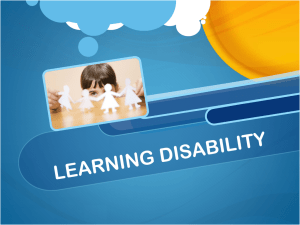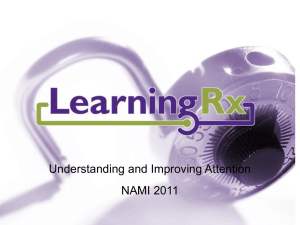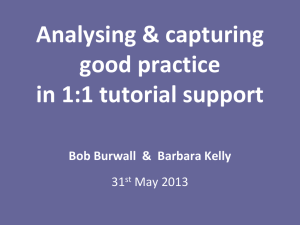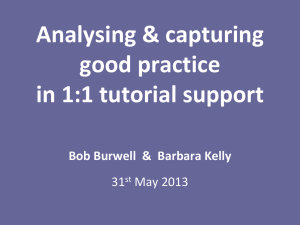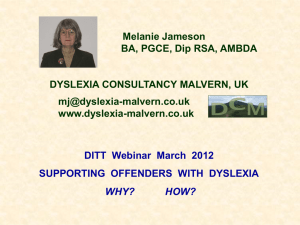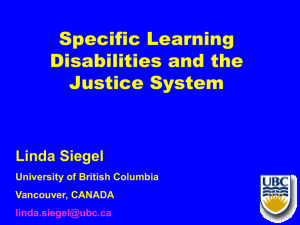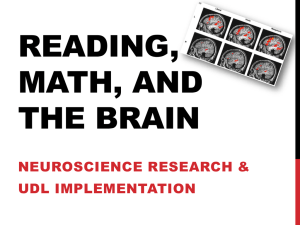Adult persons with Dyslexia - European Dyslexia Association
advertisement
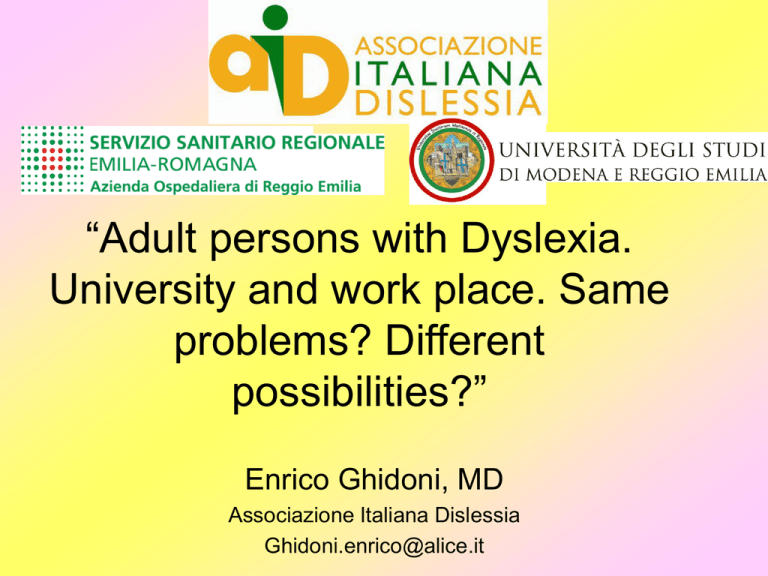
“Adult persons with Dyslexia. University and work place. Same problems? Different possibilities?” Enrico Ghidoni, MD Associazione Italiana Dislessia Ghidoni.enrico@alice.it Adult dyslexics in Italy • Estimated prevalence of Dyslexia in Italy is 3 %. • But in 2 out of 3 cases Dyslexia isn’t recognized at school. • So there are a lot of unrecognized adult dyslexics (in universities, at work, in social life…). • Dyslexia may be compensated but the neurobiological substrate is still present. Questions about adult dyslexia 1 • What are the cognitive and psychological characteristics of adult dyslexics? • Is the adult dyslexia profile different from that in the developmental age? • What are the parameters for diagnosis (reading time, speed, accuracy…)? • How many parameters must be abnormal to diagnose dyslexia? • What tools to measure these parameters? Questions about adult dyslexia 2 • Can Compensation make the disorder undetectable using any tool? • How can we define diagnostic subcategories such as mild, moderate and severe dyslexia or phonological, superficial dyslexia…… • What are the residual patterns of each SLD? Questions about adult dyslexia 3 • Are there adult dysfunctional patterns due to SLD which are unclassifiable according to common categories? • Is there a specific history pattern for every SLD? • What kind of aid and support for adult SLD? • What compensatory tools are really effective? • To what extent is research on English-speaking dyslexics transferable to our context? Questions about adult dyslexia 4 • What is the natural history of dyslexia? • Is there any advantage for those who have received a diagnosis and support? • Are there predictive factors for the evolution of dyslexia in adult age? Adult dyslexics – the facts • Persistent phonological dysfunction • Variable effect on life activities (study and work) • Psychological fall-out • Personal coping D. Pollak: Four types of dyslexic student: • The ‘patient’ • The ‘student’ • The ‘hemispherist’ • The ‘campaigner’ Pollak • Those I called ‘patients’ had internalised a medical view of dyslexia; they saw themselves as suffering from a condition which made them defective. • The next group, I called ‘students’; they focused on the discrepancy between their IQ and their scholastic attainments, and regarded dyslexia as something which affected them only in an educational context. • The ‘hemispherist’ group were good at metacognition, i.e. analysing the ways in which they learned; they were aware of their own strengths, for example in visualisation and holistic thinking. • The fourth group, I called ‘campaigners’; they viewed dyslexia as a political issue, and were determined to fight for their right to be taught and assessed in dyslexia-friendly ways. McLoughlin et al’s four types of dyslexic adult: • • • • unaware that they are dyslexic, and thus have no strategies for success aware that they are dyslexic, but still have no strategies aware that they are dyslexic, and have unconscious strategies aware that they are dyslexic, and make conscious use of good strategies. Critical issues for adult diagnosis in Italy • Adults (>18 ) are not treated by health services for childhood and adolescence • There are hardly any standardized tests for subjects over 18. • There is little interest in neuropsychology laboratories for adult neurological diseases • The examination batteries for adult acquired dyslexia were conceived to evaluate disorders which are very different from developmental dyslexia. Diagnostic demand • University and College students who want to take advantage of accommodations now available in many universities; • Students who have to take exams (state exams, public selections, driving license); • Adults who wish to go back to school to obtain secondary school qualifications; • Parents of DYS children who want to understand their own difficulties Screening in adults • Adult Dyslexia Check List, Vinegrad (ADCL) 1994 • Adult Reading History Questionnaire, Lefly & Pennington, 2000 • Lucid Adult Dyslexia Screener (LADS) Singleton, 2002 • On-line Questionnaires, Kasler e Fawcett, 2009 Project Adult Dyslexia Diagnosis • Associazione Italiana Dislessia • University of Modena and Reggio E. • Arcispedale S. Maria Nuova, U.O. Neurology Unit, Neuropsychology Lab Project phases 1 Standardization study regarding controls 2 Identification of sensitive tests (controls/dyslexics comparison) 3 Clinical study on adults, students or other 1. Standardization study • Control group: N = 80 (AVIS volunteers, students, hospital staff) • Mean values and standard deviation (percentiles for error scores) • Four age groups: 18-24; 25-34; 3544; 45-54 • Cut-off: - 2 standard deviations; • 95° percentile for error scores Test sensitivity (% positive results ) • ADCL 93% • Text Reading: • time 56% • errors 38% • speed 48% • Word lists: time 52% • errors 40% • speed 31% • Non words time 69% • errors 37% • speed 52% • Allographs time40% • Non word writing 29% Test sensitivity (% positive results ) • • • • RAN: Digits time 31% Letters time 29% Colours time 35% • Word Span 13% • Visual search matrices 27% • • • • • • • • N&D 1 time 29% N&D 2 time 21% N&D 2 time 23% N&D 3 time 33% N&D 3 errors 40% Backward counting: time 27% errors 44% 3. Clinical study: Examination procedure • • • • Clinical interview Family history Personal history (medical and educational) Neuropsychological history (previous and current trouble) • Preliminary tests (ADCL, Raven PM38, Oldfield, Beck DI, Hamilton Anxiety) DD Adult Basic Battery • • • • • • • Text, word list, non word reading Allograph Comparison Text comprehension Non word writing RAN (digits, letters, colours) Night & Day attention test Counting backwards Additional Investigation • Questionnaire /partially structured interview about self narrative • Central Auditory Processing Disorder Checklist • Psychological tools to evaluate affective relational aspects (BDI, Hamilton ) Single case in depth study • Calculation (dyscalculia battery) • Short term memory(digit span, Corsi’s cubes, word span; dual task) • Long term Memory (verbal, visuo-spatial…) • Language (fluency, naming, metaphors comprehension , verbal judgements, etc) • Writing (Luzzatti test) • Attention (Visual Matrices, Stroop, Trail making) • Intelligence (WAIS-R) • Visuo-spatial functions (Benton line orientation, Rey’s figure) University Students (N 37) • • • • • • • • • • • Primary Education Engineering Architecture Economics Communications Law Arts Medicine; Veterinary Psychology Sociology Nursing studies; Physical Education 7 5 3 3 3 3 3 3 3 2 2 Dyslexia at University • An increasing number of DYS students • Dynamics of Relationship with peers, teachers, administration • Support measures and tools • Tutoring, Negotiation, Mediation (Singleton, 2009) In Italy :estimated prevalence amongst university students 1% Results in our sample • Dyslexics are present in all degree courses. • There is a high rate of “new” diagnoses (over 60% of cases) • Academic and psychological problems are more evident if dyslexia is associated with dyscalculia In the workplace • • • • • • • Compensations and strategies A misunderstood style of work “I need more time!” Silly mistakes and managerial ability Negative stigmatization Choosing an occupation Disclosure and acceptance The world of adult dyslexics • A wide variety of ways of experiencing and understanding one’s own dyslexia (Fulgeri, 2010; Cardano, 2010) • Discovery or creation of the niche • Finding the right social and professional niche improves functional and psychological compensation Personal experience • Self narratives as a tool for reconstructing one‘s own identity • To what extent is identity building conditioned by dyslexia? • Diagnosis may be a turning point in life, a biographical transition. Dyslexic identities The social reality of dyslexia • Cultural evolution • Awareness of neurobiological ontology • Protection and support require the recognition of the difference (labelling) • Anti-label positions • Labelling and stigma: which comes first? • Ideology and stereotypes Reggio Emilia, Italy

